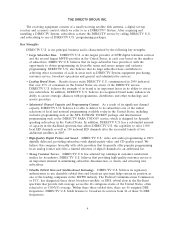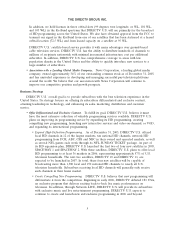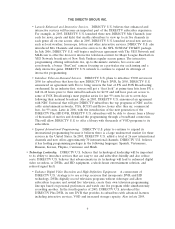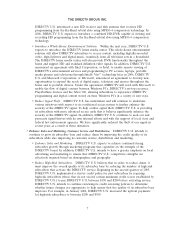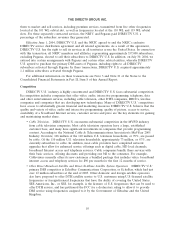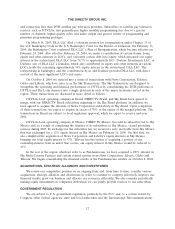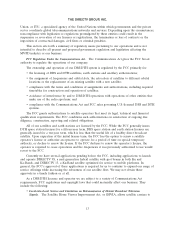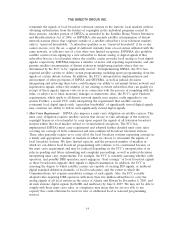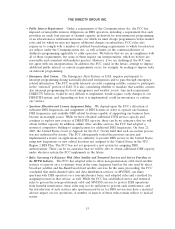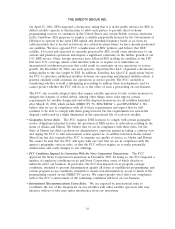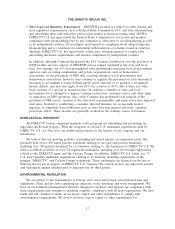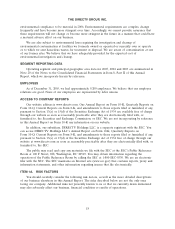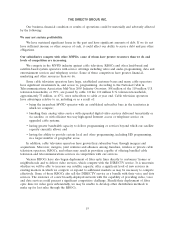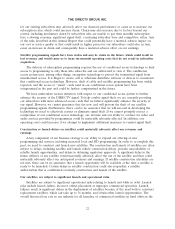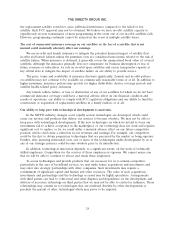DIRECTV 2005 Annual Report Download - page 27
Download and view the complete annual report
Please find page 27 of the 2005 DIRECTV annual report below. You can navigate through the pages in the report by either clicking on the pages listed below, or by using the keyword search tool below to find specific information within the annual report.THE DIRECTV GROUP, INC.
retransmit the signals of local broadcast television stations in the stations’ local markets without
obtaining authorization from the holders of copyrights in the individual programs carried by
those stations. Another portion of SHVIA, as amended by the Satellite Home Viewer Extension
and Reauthorization Act of 2004, or SHVERA, also permits satellite retransmission of distant
network stations (those that originate outside of a satellite subscriber’s local television market)
only to ‘‘unserved households.’’ A subscriber qualifies as an ‘‘unserved household’’ if he or she
cannot receive, over the air, a signal of sufficient intensity from a local station affiliated with the
same network, or falls into one of a few other very limited exceptions. SHVERA also prohibits
satellite carriers from signing up a new subscriber to distant analog or digital signals if that
subscriber lives in a local market where the satellite carrier provides local analog or local digital
signals, respectively. SHVERA imposes a number of notice and reporting requirements, and also
permits satellite retransmission of distant stations in neighboring markets where they are
determined by the FCC to be ‘‘significantly viewed.’’ In implementing SHVIA, the FCC has
required satellite carriers to delete certain programming, including sports programming, from the
signals of certain distant stations. In addition, the FCC’s interpretation, implementation and
enforcement of other provisions of SHVIA and SHVERA, as well as judicial decisions
interpreting and enforcing these laws, could hamper our ability to retransmit distant network and
superstation signals, reduce the number of our existing or future subscribers that can qualify for
receipt of these signals, impose costs on us in connection with the process of complying with the
rules, or subject us to fines, monetary damages or injunctions. Also, the FCC’s sport blackout
requirements, which apply to all distant network signals, may require costly upgrades to our
system. Further, a recent FCC order interpreting the requirement that satellite carriers
retransmit local digital signals with ‘‘equivalent bandwidth’’ of significantly viewed digital signals
may constrain our ability to deliver such significantly viewed digital signals.
•Must Carry Requirement. SHVIA also imposes a must carry obligation on satellite carriers. This
must carry obligation requires satellite carriers that choose to take advantage of the statutory
copyright license in a local market to carry upon request the signals of all television broadcast
stations within that local market, subject to certain limited exceptions. The FCC has
implemented SHVIA’s must carry requirement and adopted further detailed must carry rules
covering our carriage of both commercial and non-commercial broadcast television stations.
These rules generally require us to carry all of the local broadcast stations requesting carriage in
a timely and appropriate manner in markets in which we choose to retransmit the signals of
local broadcast stations. We have limited capacity, and the projected number of markets in
which we can deliver local broadcast programming will continue to be constrained because of
the must carry requirement and may be reduced depending on the FCC’s interpretation of its
rules in pending and future rulemaking and complaint proceedings, as well as judicial decisions
interpreting must carry requirements. For example, the FCC is currently assessing whether cable
operators, and possibly DBS operators, must engage in ‘‘dual carriage’’ of local broadcast signals
as these broadcasters upgrade their signals to digital transmission. In addition, the FCC is
assessing the degree to which satellite carriers are capable of carrying HD signals, or multicast
digital standard-definition channels, of local broadcasters, and the extent to which the
Communications Act requires mandatory carriage of such signals. Also, the FCC recently
adopted rules requiring DBS operators with more than five million subscribers to carry the
analog signals of all local stations in the states of Alaska and Hawaii by December 8, 2005, and
all such stations’ digital signals (both HD and multicast) by June 8, 2007. We may not be able to
comply with these must carry rules, or compliance may mean that we are not able to use
capacity that could otherwise be used for new or additional local or national programming
services.
14


